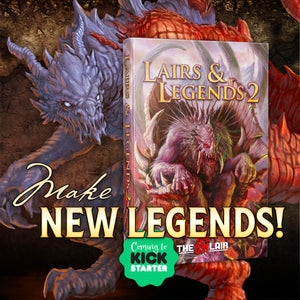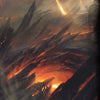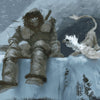Schemes, Secrets, and Sabotage: How to Run a Braunstein-Style Game

Written by Luke Hart
The royal wedding was supposed to be a peaceful affair. But the moment the cleric stood to give his blessing, the rogue assassin made his move—only to be tackled by the fighter, who’d secretly made a deal with the rival kingdom. Meanwhile, the wizard vanished in a flash of light, taking the crown prince with him. And in the chaos, the bard’s player passed me a note: “I ignite the poison gas I planted under the banquet table.”
None of that was in the dungeon master’s notes. They had just handed out roles, goals, and secrets—and then watched their D&D group set fire to their world in the best possible way.
Today we’re talking about how to run a D&D game that enhances player agency, fosters alliances, rivalries, and diplomacy, encourages creativity, features open-ended possibilities, and ultimately leads to some of the most amazing, memorable moments you’ll ever have at the gaming table. Today we’re talking about how to run a Braunstein game.
What is a Braunstein game?
To put it simply, Braunstein was chaos. Glorious, player-driven, completely off-the-rails chaos. It’s considered by many to be the very first roleplaying game—long before anyone rolled up a fighter or cast magic missile. It was first run by a guy named David Wesely in 1969, and it borrowed heavily from the board game Diplomacy. Only instead of nations, players were dropped into a fictional 19th-century town called Braunstein. And instead of commanding armies, they were playing roles like the mayor, the college chancellor, the town banker, and even the rebellious student protesters.
Each player had their own secret objectives, different pieces of information, and no fixed script to follow. There were no win conditions. Just a referee—Wesely—who made judgment calls on the fly and met with players individually to hear their plans and adjudicate the outcomes. You want to form an alliance with the student union to take down the mayor? Cool. You want to sneak into the guardhouse at night and replace the weapons with sausages? Also cool. If you could think it up, and the ref allowed it, it was in the game.
And things got weird. In one of the spin-offs, a game called Banania, Dave Arneson—who would later go on to co-create D&D—ended the session by flying off in a helicopter as a secret CIA agent with a suitcase full of cash. That’s the kind of wild energy Braunstein encouraged.
There’s no single rulebook for these kinds of games. The only thing they all have in common is this: multiple independent actors, all with conflicting goals, operating under a fog of war. You don’t know what the other players are doing. You don’t even know what’s possible until it happens. And somehow, all of it gets tied together by a referee—what we’d now call a game master.
What does this have to do with D&D?
Okay, so maybe you’re thinking: “Cool history lesson, but what does this have to do with Dungeons & Dragons?”
Well… everything, actually.
See, before D&D was a game about dungeon crawling and fireballing goblins, it was something much closer to Braunstein. In fact, Dave Arneson—who co-created D&D—started out running a game called Blackmoor, which he literally described to his players as a “Medieval Braunstein.” That’s how he pitched it. He took the freeform chaos of Braunstein and dropped it into a fantasy world, complete with magic, monsters, and swords. The players weren’t just controlling factions—they were playing individual characters. Sound familiar?
And it didn’t stop there. If you go back and read the Advanced Dungeons & Dragons Player’s Handbook—like, page seven—you’ll find clear references to players running domains, commanding armies, and even conflicting with each other. It wasn’t just adventuring together; it was political drama, territorial disputes, and faction power plays. Very Braunstein.
Over time, the game evolved. The social dynamics and PvP intrigue faded into the background, and D&D became more about party unity and tactical encounters. But those original Braunstein roots? They’re still there—just waiting for you to bring them back into your game.
So if you’ve ever wanted your players to stop being murderhobos for five minutes and start thinking like scheming nobles or warring guild leaders, guess what? You’re thinking like a Braunstein referee. You’re thinking like early D&D.
How can Braunstein dynamics be fostered in a D&D or modern TTRPG game?
Here’s the good news: you don’t need to blow up your campaign and start over to bring Braunstein vibes to your game. You just need to loosen the reins a little—and let your players run wild.
The easiest way to start? Downtime. Give your players time between adventures to pursue their own goals, and let them actually do stuff off-screen. Don’t just handwave it with “Okay, cool, you make 50 gold crafting potions.” Let them send messages. Make deals. Spy. Scheme. Suddenly, the party isn’t just a team—they’re a collection of individuals, each with their own ambitions. And sometimes? Those ambitions don’t quite align.
Now, if you want to crank the dial to full Braunstein, try assigning factions. Maybe each player is secretly working for a different noble house. Maybe they’re agents of rival gods. Heck, maybe they are the gods. Give them long-term goals, secret agendas, and reasons to cooperate—but also reasons to backstab each other when the timing’s right.
The beauty of this kind of play is that you, the dungeon master, aren’t the only one pushing the plot forward anymore. The players are generating intrigue and conflict for you. It’s organic. It’s unpredictable. And when done right, it leads to a story that’s richer than anything you could have written on your own.
Let your players be messy. Let them form alliances and break them. Let them lie, and cheat, and bribe the town guard to look the other way. That’s Braunstein. And it’s magic when it happens at your table.
Try running a “Session Braunstein”
If you’re not ready to make your whole campaign a swirling mess of secrets and hidden agendas, no worries. You can still get a taste of Braunstein-style chaos with what’s called a Session Braunstein—a one-shot or single-session event that drops your players right into the middle of a powder keg… and then hands them the matches.
Here’s how it works: pick a key event in your world. A royal council vote. A tense negotiation between rival guilds. A masquerade ball where someone’s planning a murder. Whatever it is, build the session around that event, not a dungeon crawl or linear quest.
Then, assign each player a unique role in the scenario—could be their normal character, or could be a temporary role like a noble, an assassin, or a visiting dignitary. Give them objectives. Give them resources. And most importantly? Give them secrets. Don’t worry about balance—some roles can be way more powerful or connected than others. That actually makes things more interesting.
When the session starts, sit back and watch what happens. Players will lie to each other, form alliances, try to outmaneuver their enemies—and the story will unfold without a script. You’re still the referee, stepping in to resolve actions and move things along, but the players are the ones generating the plot. And trust me, you will not predict how it ends.
It’s a great way to shake things up, spotlight political or social dynamics in your world, and get players thinking outside the usual “we fight the monster, we take the loot” routine. Plus, it’s a ton of fun.
The Ultimate D&D 5e Resource Anthology
Even as a veteran dungeon master, I'm often overwhelmed with everything I need to do to prep for a game. And I suspect others might feel the same way. That's exactly why my team and I created Lairs & Legends 2 and Loot & Lore 2.
If you’re looking for loads of 5e adventures that you can prep in under 30 minutes or elements such as traps, puzzles, and encounters that you can drag and drop into your game at a moment’s notice, we have you covered!
With Lairs & Legends 2 and Loot & Lore 2, you’ll get over 700 pages of D&D 5e resources:
- 33 Adventures
- 100+ Monsters
- Encounters
- Traps
- Puzzles
- and more!
Everything is designed to be EASY TO USE and QUICK TO PREP for your game. Our goal is to make game masters’ lives easier, not more complex!
Don’t spend another moment frustrated and overwhelmed as a GM. Pick up the Lairs & Legends 2 and Loot & Lore 2 today and find out how much easier being a GM can be!
-
Posted in
Game Master How-To Articles







